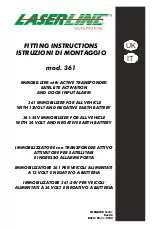
14 • 35-3001A-04-03 Carbon Monoxide Sample-Draw Detector
3. Hand tighten the nut on the inlet fitting so the ferrules clamp on the tubing. If the tube nut is
removed, see Figure 7 on page 24 for the arrangement of the fitting components.
4. Route tubing from the inlet fitting to the sample area. See “Specifications” on page 5 for
maximum tubing lengths based on tubing size.
CAUTION:
Avoid loops or slumps in the incoming sample line. To reduce response time, keep the
incoming sample line as short as possible.
5. If desired, install the particle filter onto the end of the inlet line. Be sure the arrow on the
particle filter is pointed toward the inlet line.
Installing the Exhaust Line
1. Loosen the nut on the exhaust fitting until 3 threads are visible.
2. Push 1/4” O.D. rigid polypropylene or rigid Teflon sample tubing into the fitting until it stops.
Flexible polyurethane tubing may be used with an appropriate insert. RKI Instruments, Inc.
recommends using either 1/4” O.D. x 1/8” I.D. or 1/4” O.D. x 0.170” I.D. tubing based on your
length requirements. See “Specifications” on page 5 for maximum tubing lengths based on
tubing size.
CAUTION:
If you use
flexible
sample tubing (polyurethane is acceptable), use an appropriate
insert to seal the connection between the tubing and the inlet fitting.
3. Hand tighten the nut on the exhaust fitting so the ferrules clamp on the tubing. If the tube nut is
removed, see Figure 7 on page 24 for the arrangement of the fitting components.
4. Route the opposite end of the tubing to an open area where the sample can safely disperse or to
an exhaust duct. See “Specifications” on page 5 for maximum tubing lengths based on tubing
size.
Wiring the Sample-Draw Detector to a Controller
WARNING:
Always verify that the controller is off and that power to the controller is off
before you make wiring connections.
1. Turn off the controller.
2. Turn off power to the controller.
3. Unlatch and open the housing door of the sample-draw detector.
4. Guide a three-conductor, shielded cable or three wires in conduit through the conduit hub at the
bottom of the sample-draw housing. A minimum of 18 AWG wire is recommended.
5. Connect the cable to the sample-draw detector’s interconnect terminal strip as shown in Figure
6. Close and latch the housing door of the sample-draw detector.
CAUTION:
If using shielded cable, leave the cable shield’s drain wire insulated and
disconnected at the sample-draw detector. You will connect the opposite end of the
drain wire at the controller.
7. Route the cable or wires in conduit leading from the sample-draw detector through one of the
conduit hubs at the controller.












































